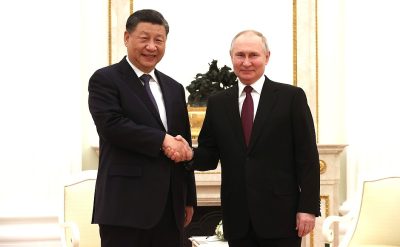ONCE UPON A TIME... IN HOLLYWOOD or Welcome to Tarantinopolis — Some Thoughts on Sergio Leone’s ONCE UPON A TIME IN the WEST, Martin Scorsese, and JOKER, by Jung-Freud

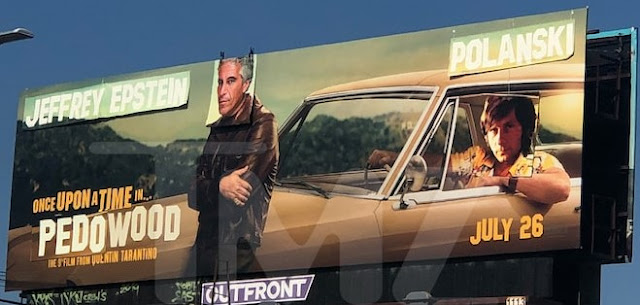
“I’m practically crying, and I haven’t even read it.” – Trudi Fraser
It’s almost as if Terry Gilliam believes ignorance is knowledge, or a kind of creative strength. While directing BRAZIL, he insisted on not having read George Orwell’s 1984 and only having heard of it. So, the movie is essentially Gilliam going off tangents on his impression of 1984’s basic concept(from hearsay, articles, movies, etc). Though critics were divided, it had its share of defenders, even being voted Best Film of the Year by Los Angeles Film Critics(though Gilliam enthusiasts dwindled with every new film with the exception of FISHER KING). Gilliam-ism is essentially a pop culture phenom sown with misconceived understanding of Art Cinema — he foolishly drew inspiration from Federico Fellini’s post-8 ½ films, the ones of increasing self-indulgence and blind megalomania — and unjustified self-aggrandizement(as he foolishly follows in the footsteps of giants, each of which could fill a thousand Gilliams; he is to Welles what the dwarfs are to ‘god’ in TIME BANDITS). The sheer discrepancy between his abilities and aspirations has rendered most of his projects moot as film art. It’s too bad because, with a more honest assessment of talent and limitations, he could have been a pretty good director. But then, Gilliam wouldn’t be Gilliam without the over-reaching. As with Ken Russell, he built his reputation of a ‘visionary’ for whom enough is never enough.

Brad Pitt and Bruce Willis in Terry Gilliam’s dreadfully over-reaching TWELVE MONKEYS
Gilliam is worth mentioning in relation to Quentin Tarantino whose imagination also happens to be tangential than integrally linked to the sources of his inspiration. Though stacked with encyclopedic knowledge of cinema and pop culture, his interest seems less that of a pedant than a peddler. He’s essentially a salesman or con-man than an artist; what matters is the deal than what is real. It’s about pulling a fast one, bamboozling the audience with just enough charm and bluff to make the sale. It’s been said a salesman is really selling himself, and this explains why Tarantino’s personality is essential to the success of his movies. He’s as much selling his brand as his movies. He lives the Glengarry-Glen-Ross lifestyle.
In the Sixties, Andrew Sarris and like-minded critics argued(persuasively) that the best of American Hollywood cinema was just as worthy of serious consideration as Art Cinema of Europe, Japan, and elsewhere. (Pauline Kael generally refrained from invoking ‘art’ to defend American Cinema that, in her eyes, required no justification other than their power as pop-mythology, with the added attraction of directness over obscurantism or pretension.) With Tarantino, the aesthetic logic works differently than with Sarris or even Kael. It’s one thing to recognize artistic worth in popular entertainment, which, after all, attracted countless first-rate talents over the years in music, theater, and cinema but quite another to wax obsessively about works that are obviously trash. It’s hard to imagine Andrew Sarris or Pauline Kael getting all excited about SWITCH BLADE SISTERS or exclaiming the ugly-demented Japanese movie BATTLE ROYALE as the best movie of the 1990s. At most, they might be intrigued by such features as socio-cultural phenomenon, as Kael was of Alejandro Jodorowsky’s TOPO, a work she detested on moral and aesthetic terms.
But then, the contrast illustrates the difference between critical acumen and creative attitude. The role of critics is to discriminate and evaluate, divide wheat from chaff. A critic may find something of worth even in a ‘bad’ movie, but he must seek what is good by standards higher than personal appeal. In contrast, creativity springs from inspiration, which can be drawn from just about anything — many artists were sparked by what, to most people, would seem trivial or nonsensical; the artistic eye sees more potential than the average eye, just like a musical talent can pick up few random notes as the basis for amazing variations. The problem with Tarantino is he’s developed both critical and creative outlooks, thereby conflating what inspires him with artistic value. Martin Scorsese shares the predilection though not to the same degree as Tarantino’s junk-addiction. Still, despite eccentricities of taste, the critical side of Scorsese has been sufficiently discerning in favor of works of historical significance and artistic & moral value. In contrast, Quentin Tarantino is a textbook case that there’s no accounting for taste. Tarantino is no dummy and has even exhibited brilliance in his works, but his sensibility is essentially trashy. His Japanese counterpart would be the vile and disgusting Takashi Miike who, like Tarantino, is not without talent but certainly without a soul. Except for his stunning debut RESERVOIR DOGS, his works have been devoid of value despite all the fashionable ‘hipsterics’ and loudmouthed preaching(especially by Samuel L. Jackson); of course, plenty of critics will disagree, especially in regards to PULP FICTION that many consider to be an all-time masterpiece — PULP FICTION generated tons of discussion, not least because its release coincided with rise of internet movie culture, but it was more about trivia than anything resembling truth. Both Tarantino and Kurt Cobain were major cultural icons in the 1990s, and in a way, BOTH blew their brains out. Cobain literally and Tarantino figuratively soon after his first feature that showed great promise that fail to materialize. At least, Fellini began to waste his talent after making several great films culminating in the incredible 8 ½. As for Gilliam, he never had much talent to waste in the first place and made a mess of his career by over-estimating his abilities.
As things turned out, Tarantino did indeed change movie history but for all the wrong reasons. As with Camille Paglia, success went to his head like crack-cocaine, and sober minds have been wondering when his feet will touch ground again. To be sure, for such a high-strung bundle of energy, a Daffy-Duck-Tasmanian-Devil of a man, Tarantino hasn’t made many movies since his debut. After the spectacular success of PULP FICTION — combination of critical and commercial success that eluded Welles with CITIZEN KANE — , it took two years to complete JACKIE BROWN, which might as well have been called PULP FICTION vol. 2. Then it took him six years to finish KILL BILL 1 & 2, inexplicable since they’re so devoid of fresh idea and inspiration. It took five years for his next major movie, INGLORIOUS BASTERDS, a big-budgeted glossy, even arty, rendition(or something-like-a-remake) of those ridiculous 70s action movies with little going for them except insane levels of violence made possible by the demise of the Hays Code in the 60s — in the new cultural climate, such movies were to violence what porno movies were to sex, and in a way, INGLORIOUS BASTERDS is war-porn about World War II. The movie was, of course, strafed with all sorts of references, allusions, and homages to works popular and obscure. The movie had one great scene — the inflamed movie screen at the end — , but it was mostly a terrible waste of time and torture on the senses. After three years came DJANGO UNCHAINED, one I haven’t seen. Mindless nihilism is bad enough, but mindless nihilism packaged as ‘moral statement’ is insufferable, indeed virtually indistinguishable from the nuttery of Charles Manson and Jim Jones, lunatics as crusaders. Then, three years later came HATEFUL EIGHT, of which what I read — some demented plot and gory violence — didn’t exactly pique my interest. Along with the release, a politicized Tarantino was making noises about ‘police brutality’ in a nation gripped by BLM insanity(and even terror). The guy who’d been peddling grotesque nihilism was bitching and whining about social injustice.

Quentin Tarantino as a thinner version of Michael Moore
Also, for someone who gained popularity for his relative lack of political correctness, his newfound role as girly-man ‘social justice warrior’ wasn’t a good fit. Or was it just a part of the American ritual of Afro-worship, that is when one isn’t worshiping homos or Jews? After all, the Jew-run media have fixed it so that the so-called ‘police brutality’ problem usually pertains to blacks, all those innocent ‘gentle giants’ and ‘kids armed only with skittles’. Tarantino’s star rose alongside those of Howard Stern and Camille Paglia, and all three banked on their boldness and penchant for outrage. The last thing they should do is serve a poster-child for PC.
Of course, even though all three had plenty of detractors and even haters, they were palatable to the Liberal and/or Jewish establishment because they were either Jewish(Stern) or reliably Philo-Semitic and libertine, the bread-and-butter mode of most Pop Culture(especially as it’s turned more pornographic in sex and violence over the years). All three exemplified safe and approved ways of being ‘politically incorrect’, as opposed to the truly threatening voices on the secular right. They represented a way of having the cake and eating it too: Being promoted as a maverick and saying/doing outrageous things but mostly in matters of sex-and-violence than of who really controls America that controls the world. It was good for the trio, and it was good for Liberals who craved some hipster cred against seeming overly priggish and censorious. Thus, Libs who regard ‘nigger’ as anathema could laugh at its voluminous usage in PULP FICTION with foreknowledge that Tarantino isn’t really a ‘racist’ but using it as a badge of honor, like Eminem. INGLORIOUS BASTERDS had anti-PC vibes despite the PC politics.
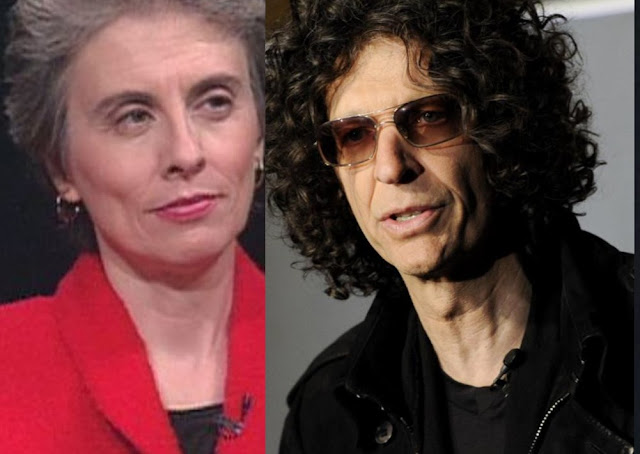
But with the release of DJANGO UNCHAINED, Tarantino was pontificating like Ken-Burns-on-steroids(or-crack). Whatever we may accept from Tarantino the nihilo-monster, moralizing shouldn’t be one of them. The only church Tarantino belongs to is that of the hipster-gangster whose sound-and-fury is all noise and no sense.
Watching PULP FICTION in 1995, I couldn’t help feeling, “This is the kind of movie Charles Manson would have made.” In a way, Tarantino’s cultural impact has been far more insidious than Manson’s — both Manson and Tarantino have been Rasputin-Svengali-like creatures — , and by a magnitude many times greater. After all, the loathsome Manson had a small following. Also, the world readily recognized him for the sicko he was, and his followers were rightly seen as imbeciles; they were not celebrated. In contrast, even though Tarantino hasn’t literally killed anyone, his cinema has been one of the most soul-destroying. Even without murdering bodies, you can murder souls. As I recall, the reactions of young audience members in the screening of PULP FICTION were maniacal, demented, and cult-like, a shameless revelry/rapture in hipster nihilism as sermon and orgy(or ‘sermorgy’) spiked with the conceit of ‘getting it’, not unlike the hive-mind buzz among the Manson kids in ONCE UPON A TIME… IN HOLLYWOOD; they believe themselves to be on the same wavelength. Jerry Lewis had his Jerry’s Kids, and one could say countless members of the X-ers and Millennials became Tarry’s Kids, among whom Tarantino’s mindless cinema comprised some of their key influences.
Granted, even without Tarantino, there would have been no end in sight in the rise of cultural degeneracy and lunacy(which could be traced back to the 1970s with the advent of pornography, blood-soaked action movies, and gory horror; one saving grace back then was the bulk of the American Population had experienced their formative years prior to the ‘youthenizing’ 60s; it was really with the boomers that people grew older physically without accepting it psychologically). Also, dominance of Network TV and, as yet, absence of home video & cable(not to mention the internet) ensured that Adult Material, from R-rated movies to pornography, would be restricted to certain segments of the population. By the 1990s, many young people had access to all sorts of lurid stuff via home video and cable(that also changed the tone of Network TV), and the internet was rapidly altering the dynamics of pop culture. Furthermore, especially with the fading of religion & the more puritanical strains of feminism and the concomitant rise of Rap Music & Jungle Fever(what with the top white female pop star ‘madonna’ promoted as the poster-child for young girls across the nation) — and of course, the seismic political transference of power from the ‘greatest generation’ to the ‘boomers’, among whom Jews were most prominent in ascendancy — , the cultural tectonic plates were shifting in profound ways.
Amidst changes all around, Tarantino stood somewhat apart as an agent of the Zeitgeist in much the same way as Trey Parker & Matt Stone(of Southpark) and Mike Judge(of Beavis & Butthead) did. Because of the willingness to join in the conversation and the ‘cool’ factor — as the ugly duckling who spread his wings to become the black swan of Indie cinema, or geek-dork or ‘gork’-turned-culture-jock — , he became to the 90s what Bob Dylan was in the 60s. (And just as Dylan’s politics were, or grew more, ambiguous enough to engage all sides, Tarantino’s movies radiated a certain mystique open to all manners of interpretations. One might say DJANGO UNCHAINED was his “Hurricane”, the Dylan hit that was full of BS, which Dylan himself knew to be untrue.) For members of the so-called Generation X and Millennials, PULP FICTION’s impact was not unlike that of SERGEANT PEPPER’S LONELY HEARTS CLUB BAND on the Boomers. It was a proud badge of their generation, something they could claim as their own, especially gratifying as the boomers had been reminding the world that all the cool, groovy, and original stuff happened in the 60s, or at the latest, the 70s. And yet, PULP FICTION also appealed to the Boomers because Tarantino paid fulsome homage to idols and images of yesteryear. It was like nostalgia minus the sappy sentimentality. The old was refurbished into something fresh and fashionable. (Another appeal to older viewers was Tarantino’s Midas Touch when it came to reviving forgotten actors & actresses, the stars of their youth who’d fallen out of favor or been written off almost permanently, just barely scraping by in bit roles or low-budget movies. Tarantino didn’t merely bring them back for an encore but made them ‘cooler’ than ever. Doc Tarankenstein was like the greatest paramedic in movie history, the opposite of Nicolas Cage in BRINGING OUT THE DEAD who can barely save anyone. The voltage that Travolta got from PULP FICTION was such that he was offered role upon role, and it took some years before his star faded again, especially with the utter monstrosity called BATTLEFIELD EARTH.) If the Beatles album epitomized the synthesis of Pop and Art(between youth culture and adult culture), PULP FICTION was celebrated as a post-modern breakthrough that erased the boundary between Art House and Multiplex; it was also a ‘shared’ experience like no other across generations because young ones punked to its neo-hipster vibes while older viewers had fun with ‘spot the reference’. It seemed both youthfully irreverent and nerdily reverent.
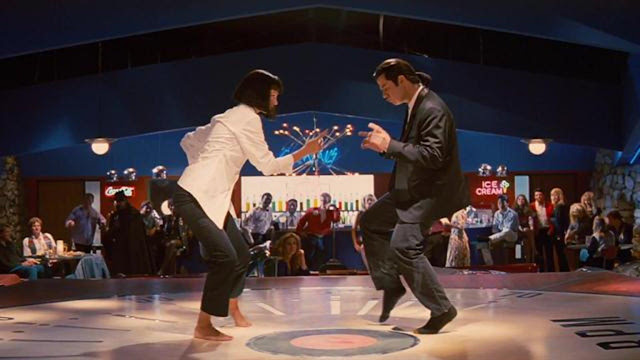
Uma Thurman wigged up like Anna Karina and John Travolta in PULP FICTION
For the young it was a natural extension of MTV while for older viewers it could be an homage to Jean-Luc Godard and the tradition of Film Noir. While there had been breakout hits and works of cross-over appeal in Indie Cinema, there was nothing quite like PULP FICTION that blew the top equally as Indie-Art film and Hollywood movie, not least because its cultural allusions were as much to European as Hollywood cinema. It wasn’t so much a case of Indie doing Hollywood or vice versa but a near-total post-modern fusion of both modes like never realized before. It was so very Hollywood(and MTV) but then so very personal in the European ‘auteur’ sense. It was ‘cool’ and cerebral, ‘experimental’ and accessible, vulgar and sophisticated. It was one of those things that people, high and low, had long been waiting for without knowing what exactly they were waiting for — something they would realize had been missing in the culture only upon its materialization, seemingly out of nowhere; there was this sense with the Beatles as well, i.e. they were so fresh and novel yet so essential, as if to make one wonder how humanity had managed all these years without the Fab Four; and of course, the same could be said of the arrival of Jesus as Christ — before Jesus, people went on with their lives as usual, but after Jesus, the faithful couldn’t conceive of a world without Him. PULP FICTION also spoke to the Clinton 90s, as did AMERICAN BEAUTY but in a more brazen, visceral, and uninhibited manner. If Sam Mendes’ movie pretended to have a point, the allure of PULP FICTION was the point was besides the point. It’s like what the old man says in RESERVOIR DOGS: “You don’t need proof when you have instinct!” The style is where it’s at. (Perhaps, the Tarantino of the 2010s is Lin Manuel-Miranda, the clown who concocted HAMILTON in which pomo has come full circle, indeed to the point where a quasi-aristocratic Alexander Hamilton is re-imagined as a ‘progressive’ groid or ‘progroid’; the farcical charade has been stretched so far that irony, so intrinsic to post-modernism, has warped into earnestness… or is it a put-on-naivete as a wink-and-nod to ‘wokeness’?
But if the tomfoolery of HAMILTON was done with humor and high spirits, the Wakanda-mania of BLACK PANTHER would have us believe it could be or should be all so true. Still, if HAMILTON and BLACK PANTHER have one thing in common, it is the CONVICTION that blacks are nobler. That catechism, above all, is the reason for their spell over so many people, high and low. Despite the hijinks and laughter, what really completes HAMILTON is it made the audience, even the sophisticates, boo-hoo-hoo cry. All said and done, this seemingly ironic pomo-work made them BELIEVE, hallelujah. On that note, it goes to show that, at the end of the day, sincerity beats cynicism. While Howard Stern, Quentin Tarantino, Bill Maher, South Park guys, and Camille Paglia in the 90s were effective slayers of sacred cows, when the dust settled people still gravitated toward sanctity, and in this sense, Oprah and BROKEBACK MOUNTAIN beat out Tarantino’s hipsterism. Irreverence can be hip and cool but doesn’t provide meaning, a vision of the sacred. In contrast, BROKEBACK MOUNTAIN sacralizes cowboy-sodomy as godly and heaven-sent, hallelujah brother. This may be one reason why, with DJANGO UNCHAINED, Tarantino played moralist for a change to win plaudits as a believer.) While it’d be foolish to blame Tarantino in particular for the cultural-moral rot that befell American culture and sensibility, there is no doubt that he was a key contributor with his brand of hipster nihilism where style is substance and amorality is the basis of reevaluation of values. We will never know what forces were really behind the spate of school shootings(and other demented mayhems in public places) since the Columbine massacre, but what they all have in common is the mentality that can no longer distinguish reality and fantasy — to be sure, Adolf Hitler was a pioneer in having played history as grand Wagnerian opera. To these disturbed souls, reality seems an extension of their video-game & pop-cultural universe and vice versa(not least because video-games become ever more ‘realistic’ in graphics and player-participation), which makes matters even more frustrating because reality doesn’t conform to ‘rules’ that govern games and entertainment. Far more damaging than the violence in Tarantino’s movies has been their attitude, a mix of glibness, sadism, disaffected smugness, and/or mock-righteous indignation. A particularly vile scene is one where DeNiro’s character guns down Bridget Fonda’s in JACKIE BROWN. However adults may process or rationalize such a scene, its impact on young ones can only be deleterious in the worst way.
Another annoying thing about Tarantino is toadying attitude toward his idols, real and imagined. In a way, despite his risque posturing and maverick demeanor, Tarantino isn’t much different from the character of Henry Hill in GOODFELLAS who, from a young age, wanted nothing other than to be one of the ‘wiseguys’ who seemed to have it all. Ostensibly, Henry is one of the crew, a tough guy, but he’s really a servile punk who sucks up to the real tough guys with bigger balls. Likewise, so many of Tarantino’s movies are fanboy love letters to his favorite stars and (anti)heroes. Instead of finding value in life as it is and in people as they are, Tarantino’s personal fantasy has been to gain ‘coolness’ points by making hyper-homages to the icons of cool. In a way, he’s like the court-jester or class clown desperate to curry favor with the big men on the campus. (Perhaps, Linklater is more balanced because he was once a genuine jock in football and baseball.) Instead of Revenge of the Nerds, it’s more like Redemption of a Nerd or Malaka(like in WEIRD SCIENCE) by concocting something so ‘cool’ that even cool kids may come flocking around it. In this, Tarantino is rather like C.W. Moss(Michael J. Pollard)’s character in BONNIE AND CLYDE, a toady who will do just about anything to be in good graces with the beautiful killer-couple.
Anyway, unlike Manson whose cult was limited to a tiny following, Tarantino’s movies have led to formation of hordes upon hordes of Tarry’s Kids given the nature of cinema(and his undeniable talent in pandering to youths). There’s a joke about Jerry’s Kids, “What has a million legs and can’t walk?” One about Tarry’s Kids might go, “What has a million souls and can’t feel?” In a way, Tarantino’s despicable moralizing in interviews about DJANGO UNCHAINED was less a sign of conscience than lack thereof. The soulless, lacking a truly autonomous sense of right-and-wrong, must attach themselves to dogma to feel justified. Their souls are incapable of generating autonomous meaning and sense. And so, they seek ‘spiritual’ fulfillment by joining an outrage mob and chanting in unison. Such types are triggered by truth and honesty. It seems that until DJANGO UNCHAINED, Tarantino regarded himself as too hip and ‘cool’ for ‘commitment’. But soul abhors a vacuum, and Tarantino filled his with Nigga-Worship as have so many Americans whose lives revolve around black sports, black music, and the narratives of Civil Rights. It’s likely that Tarantino is still the dumbass that was fulminating against ‘police brutality’. Or, maybe he’s starting to see things in a different light, not least because he himself became an object of an outrage mob for his close association with Harvey Weinstein. (While it’s all very entertaining to see the likes of Weinstein on the ropes, the ‘morality’ of the #MeToo movement is on level with Tarantino of DJANGO. Many of these shameless, slutty, and/or soulless women have been unscrupulous social-climbers hardly averse to resorting to any wile/guile to get theirs, but all of a sudden, they play poor innocent victims, damsels in distress, who need rescusing from the Monster Jew Weinstein. Ladies, or Skanks, it takes two to tango. Skankrusade is about as valid as nihilist-inquisition. There is something to what Jordan Peterson said: “Clean up your own bedroom first.”)
RESERVOIR DOGS is about 90 min whereas ONCE UPON A TIME… IN HOLLYWOOD runs over 2 hrs and 30 min, yet the former says so much while the latter says so little. Still, by latter-day Tarantino standards, it’s a rather reflective(and even contemplative) work, one that suggests perhaps a readiness to step into the role of ‘veteran’ or ‘master’ than stick with the enfant-terrible ‘maverick’ shtick. Well, it sure took long enough. Through the 80s and 90s, one wondered if the Coen Brothers would finally drop their smartass film-school antics and settle into roles as master-film-makers, and lo and behold, something I never thought possible actually came to be. Coens did mature into master film-makers. Though I haven’t seen DJANGO UNCHAINED and HATEFUL EIGHT — and wish I hadn’t wasted my time on the movies following RESERVOIR DOGS — , what I read about them doesn’t whet my appetite. In contrast, ONCE UPON A TIME… IN HOLLYWOOD seems like a work by someone who no longer feels he has to prove something, like he has a HIP on his shoulder. It is less about attitude than acceptance, a more honest assessment of life and its limitations. There’s even an element of grace. In a way, it is as counter-Tarantino as it is Tarantino, in the way that Clint Eastwood’s later action movies grew past the rather unblinking(and unthinking) sadism of his earlier works. For those who’ve heard Tarantino drone on(profusely on just about any topic related to movies and pop culture), the most notable aspect of ONCE UPON A TIME… IN HOLLYWOOD may be that its most admirable character(played by Brad Pitt) is a man of few words while some of the most crazed/demented characters are full of gab. Ghoul-faced Sadie, a Mansonite expounding as to why the crew should go murder Rick Dalton(Leonardo DiCaprio) first, eerily echoes Tarantino-ism(or pothead Slater-ism of DAZED AND CONFUSED). These kids go for ‘trip sessions’ and get pretty talkative or ‘Talmudic’ about their instant-karmic revelations. They rap in the manner of counterculture philosophers teasing out hidden patterns and meanings. It’s like the Tarantino Meme about TOP GUN really being a ‘gay buddy movie.’
If you want to play mind-games, you can connect anything with anything. In contrast, Booth is a man of few words. He is walk than talk. Though he is victorious over the ‘hippies’ in the movie, the sad truth is that the Sadies of the world took over the institutions and eventually won the ‘culture war’ by mastering and monopolizing the power of words, whereas the stoic American Hero type deemed it beneath his dignity to bitch, whine, and emote endlessly about everything under the sun. (The other Tarantino-movie character most like Booth is Mr. Blonde played by Michael Madsen in RESERVOIR DOGS. Neither man says much and both are tainted by the past, though Mr. Blonde is in a business that values psychopathy as an asset than liability. And yet, even though Mr. Blonde is the most demented character in RESERVOIR DOGS, he is also the most loyal and trustworthy, at least to the outfit he belongs to. He can be a cold-hearted murderer or psycho-sadist, but he is resolutely devoted to his boss and his friend, the boss’s son. His loyalty is as psychotic as his cruelty: absolute and total. Likewise, Booth is the sort of guy who keeps his word and sticks by his partner no matter what. He’s like what John Cusack’s character says of the hypothetical buddy ‘Nick’ in THE SURE THING.)
Perhaps, the older Tarantino is somewhat weary(and even regretful) of the kinds of ‘cleverness’ he spouted off throughout his career. What once sounded inspired may now sound rather silly. Worse, while there was only one Tarantino in the mid 90’s — at least prominently — , Tarantino-ism has infected an entire generation that went on Youtube with their own quirky, eccentric, or goofy takes about pop culture and movies. Then perhaps, Tarantino is feeling the pressure to grow beyond himself. Too many millennials may have gotten under his skin to the point of making his skin crawl. He might feel like the famous actor in BEING JOHN MALKOVICH whose mind and body are taken over by others. Youtube and other social platforms multiplied hipster voices by magnitudes unthinkable even in the 90s.
It’s been said of Jews, they are the ruling elites but still act like upstarts. Likewise, Tarantino has been an established star-director for over quarter of a century but hasn’t abandoned the enfant-terrible shtick, which is all the more annoying as he’s been the darling of critics and the industry, which would actually make him an enfant-adorable, a spoiled baby. His maverick-mystique has been an ego-inflating marketing ploy that stunted his growth, all the while obfuscating its drag on him as an artist? One positive sign of ONCE UPON A TIME… IN HOLLYWOOD is Tarantino, like Coens in the late 90s, may finally be ready to step into the shoes of a master who has outgrown childish things. Unlike Gilliam, Tarantino has talent to burn, except he’s burned too much of it in trash bins.
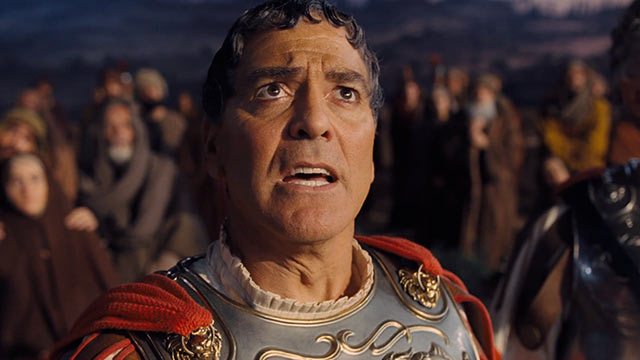
George Clooney in HAIL, CAESAR! by the Coen Brothers
ONCE UPON A TIME… IN HOLLYWOOD or OUTH may be channeling Coen Brothers’ HAIL, CAESAR!, a rather risque move since it was a commercial failure(and didn’t gain much traction with critics either). Also, considering that Tarantino’s last outing, THE HATEFUL EIGHT, was a flop, he was surely under pressure to generate a hit. And in that regard, OUTH plays it both bold and safe. It lacks the daring of RESERVOIR DOGS and PULP FICTION(and the sheer lunacy of INGLORIOUS BASTERDS). It hedges its bets in more ways than one, and some might compare it to the crowd-pleasing UNTOUCHABLES, a movie loved even by those who detested Brian DePalma, such as Stanley Kauffmann; others might say it is more comparable to CARLITO’S WAY, DePalma’s richest and most magnificent work. And yet, the scale and scope are grander, albeit ultimately lacking in the kind of insight or depth found in Kubrick films or even Coen movies(as HAIL, CAESAR! was one of the most thought-provoking concept movies in recent years, touching on the profoundest spiritual and historical questions within the framework of light comedy; it was like an impossible blend of George Cukor and Stanley Kubrick, a Cukobrick).
If the Coens fiddled with the Biblical Epic within the context of the Cold War to shed light on historical ramifications stemming from the syncretism of Jewish Prophecy and Roman Might, Tarantino used the Western as metaphor for the American Paradox of justice borne of greed and vice versa. After all, mythology of the American West rests on both the attraction of conspicuous freedom and the awe of heightened terror, with which to extend one’s freedom(at the expense of the competition). Freedom in the West meant more individual liberty but which could be used to rob others of property. Unlike in Old Europe and the East Coast where the winners had already been established in the Age of Aristocracy, the Wild West lay bare for the taking. It promised freedom and opportunity but also the certainty that some men would grab the bigger slices with more guns and guts. Thus, less tyranny actually meant more terror, something we now see in Libya and Syria where the decline of central authority, tyrannical as it may have been, has led to roving bands of cutthroat killers. Unlike the Sicily of THE GODFATHER movies, the world of the American Western is devoid of concentrated tyranny, but this means more individuals trying their luck to be top honcho, leading to copious amounts of bloodshed — indeed, the actual Wild West had a very high murder rate. In contrast, despite the threat of violence that always lingers over Sicilian society in THE GODFATHER saga, the bloodshed is mainly between clans or out of personal vendetta; it’s not about ‘every swinging dick’ flashing a pistol to show he’s numero uno. Though the Wild West was tamed soon enough and policemen & lawyers took the place of hired gunmen & frontier marshals, there persisted the cowboy-gunslinger mindset in US capitalism and social dynamics, the idea that you must make ‘your move’ to be somebody in the winner-takes-all sweepstakes; the core mythos of Americanism says it’s not enough to be just anybody; instead, you gotta be that special somebody, a prize that only comes with an element of risk.
Indeed, the contest of ‘winners’ and ‘losers’ in American mythos goes far beyond what one might find in Europe or elsewhere. One thing for sure, a director or movie star who makes it in Hollywood outshines everyone else in the cultural constellation. It’s no wonder so many directors prefer to make mediocre movies in Hollywood than more personal or higher-quality films in their nations of origin. Hollywood matters regardless of quality because of its sheer power and wealth. It is to popular culture what Washington D.C is to the global empire. Ironically, the relative functionality of Rule of Law made the cutthroat competition even more extreme. In an absolute state of chaos without any order whatsoever, most individuals would be too cowered to try out their luck. In the US, the rule of law, though far from complete, let alone perfect, emboldened more individuals to take a chance as they could lean on the law as crutch or training wheels. The presidency of Donald Trump showed the mythos is still alive. The Donald strode the stage like a combination of Elvis Presley and John Wayne. The electric gunslinger.
ONCE UPON A TIME…IN HOLLYWOOD falls short as a concept picture relative to HAIL, CAESAR! because Tarantino isn’t much of a thinker; for all his gab, his forte is instinct and intuition than intellect and ideas. Unlike the Coens, both of whom completed formal education and one of whom has a degree in philosophy, Tarantino is like a hipster version of a used car salesman. It’s all about the pitch, one so persuasive that even the bullshitter falls for the bull. At best, the quality of Tarantino’s thought is Peak Geek. He can dazzle listeners like a Poker Dealer with oddball opinions and shuffled references, but he’s not a Big Idea man. Too ignorant of reality and history, too petulant to take in the big picture, and leading with the mouth than the brains. (Coens are thinker-writer-directors. Tarantino is a talker-writer-director. There are two kinds of people in this world. Those with reason before their emotions, and those with emotions before their reason. This is not a matter of IQ because plenty of smart people lead with emotions, a common feature among Jews and Nicholas Nassim Taleb, where plenty of not-very-smart people lead with reason.) Another reason for OUTH’s relative absence of Big Idea has to do with its theme of chance, or history as a game of roulette than chess, though ‘accidentalism’ could be conceived as a high concept.
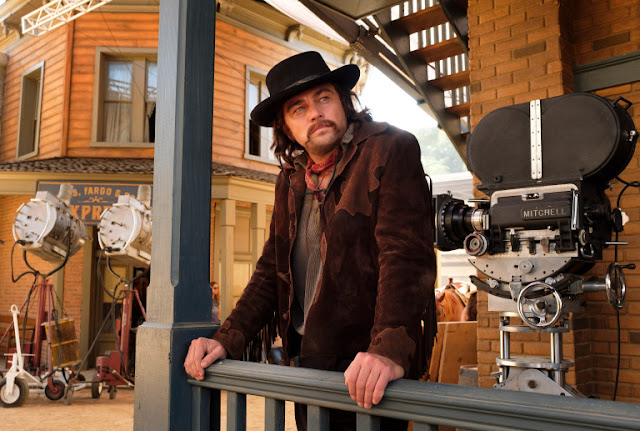
If there is an element of grandeur to OUTH, it owes to the blaring contradictions between conception and construction. The title alone makes it sound epic. Sergio Leone’s ONCE UPON A TIME IN THE WEST staged an epic struggle of the Wild West. It comprised everything from railroad tycoons and hired killers to outlaws and avengers. And the woman who, as carrier of water, is caught in a complicated web of conspiracy, ambition, pride, greed, and vendetta. ONCE UPON IN A TIME IN AMERICA was less mythic in presentation — it was even intimate at times — but grander in chronology(made dreamy with shifts in time), spanning from the dawn of a special friendship to its tragic end. And DUCK YOU SUCKER(released in Europe as ONCE UPON A REVOLUTION), though a wild and uneven mix of comedy and tragedy, canvassed the epic struggle of the Mexican revolution(with flashbacks to the Irish Independence movement) as backdrop to an unlikely but ultimately touching friendship between a radical and a bandit. As OUTH is just over 2 ½ hrs, it sounds like a Big Movie about a Big Subject with a Big Message, indeed like a movie that does for Hollywood what THE GODFATHER did for the mafia and CASINO for Las Vegas. But actually, the movie takes place in just two days. Three to be exact, but the opening day(in which Mr. Schwarz[Al Pacino] presses upon Rick Dalton[Leonardo DiCaprio] to star in Spaghetti Westerns, Brad Pitt feeds the dog, and Polanskis attend a party at the Playboy Mansion) merely serves as prelude to second day and third day. Weight of the movie rests on the shoulders of two days separated by 6 months(during which time, we are told by voice-over-narration, Dalton made movies in Italy and got married). Of the two days, the second day is considerably longer & more important(as the centerpiece of the movie) than the third, which is mainly a setup for a ‘shootout’(albeit with knives and a can of dogfood) that every Western(or a tribute to the Westerns) must have. (The arrival of Schwarz to the lunch meeting is a real coup. In a manner of Leone-ism crystallized, Tarantino only shows the close-up of the hood ornament in motion against the blurred background until it comes to a halt by the restaurant. That status symbol is all you need to know about who Schwarz is and what makes Hollywood tick. It’s a world of instant-aristocrats or ‘instacrats’. None other than Polanski is introduced as an ‘instacrat’, a poor boy who grew up in communist Poland now driving around in fancy antique model and donned in aristo-counterculture attire. So, Schwarz insists on a classier pronunciation of ‘Schwarz’ as ‘shoo-war-ze’, which, I suppose is the equivalent of Quarter-Pounder being called Royale with Cheese in France.)
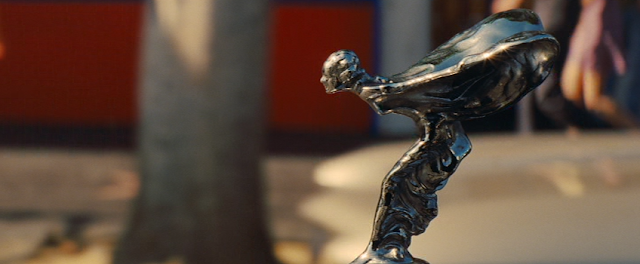
Arrival of the Shu-warzzz Mobile
All in all, the concept behind ONCE UPON A TIME… IN HOLLYWOOD implies grandiosity, but the construction is actually exceedingly modest. This aspect may have been the central challenge on Tarantino’s part. How to make an epic-seeming movie about a huge subject — Hollywood the dream-factory of the world and metaphor for Americanism — over mostly two days where the plot mainly revolves around (1) Dalton as washed-out actor doing a bit-part in a second-rate TV pilot (2) his friend/chauffeur Booth killing time between driving the boss to and from work and (2) ‘Sharon Tate’ watching herself on the big screen at high noon. Now, if someone said material so slim could serve as the basis of an epic-sized movie, you’d surely laugh. Yet, Tarantino overcomes the contradiction of conception & construction and nearly achieves the feat. He does this by yet another contradiction that synthesizes traditional cowboy tropes with counterculture hippie ones. This aspect is reminiscent of LOST IN AMERICA with its yuppie-hippie fusion: Albert Brooks as jilted yuppie careerist goes ‘hippie’ and embarks on an epic journey of self-discovery only to run out of money and scurry back to the big city.
In a way, Tarantino is like the Brooks character. Not because he started out as a well-paid yuppie who gave up his career for the creative pursuit — he was a lowly video-clerk prior to his rise to fame — but because he’s been a poseur than a purist. Just like the ‘hippie’ shtick is a dress-up game for yuppies in LOST IN AMERICA, Tarantino has been a faux-auteur or ‘fauteur’ riffing on the authentic achievements of other artists and mavericks with truer visions. In one scene in OUTH, Rick Dalton insults one of the Manson Youths as ‘Dennis Hopper’, and it’s true enough that if any film-maker came close to being the Manson-of-Hollywood, it was none other than Hopper, a man so crazy that he alienated just about everyone around him. (Even an actor as eccentric as Marlon Brando couldn’t stand him. One wonders what would have happened if Hopper crossed paths with Klaus Kinski.) Yet, crazy as he was, Hopper was the genuine article. Though EASY RIDER soon became dated and THE LAST MOVIE was both a critical and commercial disaster back in the day, they are clearly works of someone who put the pedal to the metal, much like Sam Peckinpah with THE WILD BUNCH, PAT GARRETT & BILLY THE KID, & BRING ME THE HEAD OF ALFREDO GARCIA and Francis Ford Coppola with APOCALYPSE NOW. All three were like method-directors, pushing the envelope, making movies with true grit. The danger was it was one hell of a way to burn out, and they did, sooner than later. Peckinpah found it increasingly difficult to find work. Hopper was lost in the wilderness for years before sobering up(somewhat) and making a comeback, mostly as an actor in demented roles. Coppola never fully recovered from APOCALYPSE NOW. He left a piece of himself in the jungle.
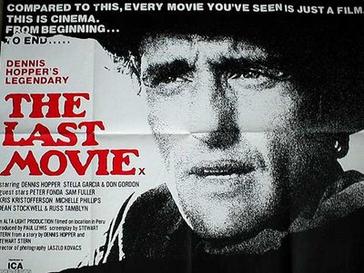
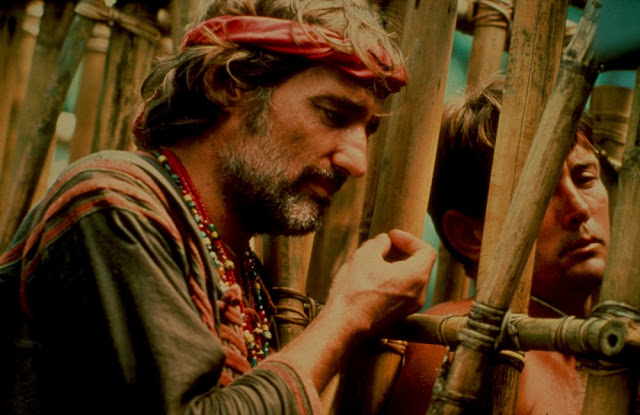
Dennis Hopper with Martin Sheen in APOCALYPSE NOW
In contrast, Tarantino, like some of his peers, is still in one piece and going strong. Though middle-aged, he still seems high-spirited or reasonably good shape: A soldier ready for battle than a weathered veteran. Same could be said of Richard Linklater, David O. Russell, Wes Anderson, Alexander Payne, Steven Soderbergh, and the rest of them. Yet, with the exception of Richard Linklater(at his best), the crop of film-makers that emerged in the 90s don’t seem as invested in heart-and-soul as the ones who made their names in the 60s and 70s. A certain glibness, smugness, timidity, or pomo irony infects their works. As for directors with a more heartfelt approach, they’ve tended to be sappy, sickly, or sensationalistic. Think of P.T. Anderson, Todd Solondnz(who wears his ‘pathosis’ — the state of being pathetic — on his sleeve), and Darren Aronofsky. (Chris Nolan is all over the map, as is M. Night Shylamalan.) What most directors since the 1990s have in common is the care not to burn out like the mavericks of the late 60s and 70s. (They are also more willing to work on huge commercial projects like comic book and 007 movies.) Even drug-users among them seem to have it more under control. This caution, while laudable, may have had a limiting effect on their imagination and ambition. Ever mindful of the warnings of Nurse Ratched, they fear to go Full McMurphy. P.T. Anderson may be the most ambitious of them with works like THERE WILL BE BLOOD and THE MASTER, but there is in him too much of ‘Ken Burns’ and not enough Peckinpah-Coppola, the stuff of true visionary devil-may-care leap into the unknown. His movies have the look but not the feel. It’s telling that the most shattering movie since 2000 is MULHOLLAND DR. by veteran director David Lynch though, by some devilish fortune, Aronofsky finally hit it out of the ballpark with MOTHER!
Now, this isn’t to suggest that film-makers should risk sanity and ruin their health with mad obsession. However, IF the film-maker fashions himself as a maverick or visionary, he must be willing to fall in with total commitment of heart and soul. It’s what Morgana says to Merlin in EXCALIBUR when he warns that the charm-of-making may burn her. She replies, “Then, burn me.” It’s like a boxer enters the ring with the full knowledge that he may get KO’ed, crippled for life, or even killed. But, that’s the only way to be a true champion. You cannot pull punches nor expect the other side to. (In Rock, some of the best music was made by people who held nothing back. It is one thing they had in common with Beethoven.) Indeed, ‘Bruce Lee’ makes just this point in OUTH as he talks about Cassius Clay and Sonny Liston, even though he himself is a showbiz charlatan who avoids real fights with truly tough men — on the other hand, he was an obsessive who pushed his body to the limit. It’s no wonder Stanley Kubrick only completed only twelve films. He needed plenty of recovery-and-preparation time for his uber-ambitious projects. It’s no wonder Sam Peckinpah increasingly turned to drugs to ease the pressure. In EXCALIBUR Merlin says to Uther, “Oh, I have slept… for nine moons. What I did for you wasn’t easy. Now, you must pay me.” and to Arthur, “I once stood exposed to the Dragon’s Breath… It took me nine moons to recover… Never again. Never.” Just like a boxer who fights the fight of his life doesn’t walk away without leaving a big chunk of him in the ring, an artist who gives his all has to give up something.
Now, this isn’t the case with all kinds of creativity. Eric Rohmer had a long distinctive career as a craftsman of modest films. But a director who stakes his reputation on going all in has to risk everything… like a gunfighter who stares at death right in the eye. It’s like what Noodles says to Max in ONCE UPON A TIME IN AMERICA. Max wagered everything and played for keeps. He must know the score and be willing to pay the price. “…a man in your position, with all your power and all your privileges, has to assume a certain amount of responsibility… a certain amount of risk.” Tarantino’s self-promotion as a maverick implied he lived by the motto “my way or the highway” — it’s like Steve Buscemi’s character in RESERVOIR DOGS insists on not paying the tip or on a name less ‘faggoty’ than ‘Mr. Pink’, but when push comes to shove, he folds before the man made of tougher stuff; he remains in the lane than takes the highway — , and yet, except for his great debut, there was always an easy-breezy glibness about his works, even in one as stylistically audacious as PULP FICTION and conceptually crazy(and ludicrous) as INGLORIOUS BASTERDS. His post-RESERVOIR movies didn’t really risk or reveal anything but a penchant for nihilism-for-nerds. It all seemed like one big put-on, a con-man repeating his tricks one too many times.
In contrast, Dennis Hopper was as crazy as the movies he made. He was not a ‘larper’. And Roman Polanski was as twisted and perverse as he billed himself to be: A diseased genius. It’s the difference between Keith Richards and Marilyn Manson. The Richards that composed “Gimme Shelter” had been to hell and back. In contrast, Marilyn Manson’s deviltry was a gimmick. Hardly an original or visionary, he pilfered others and fashioned a Rocky Horror Shtick for himself. Whatever one thinks of Hopper’s THE LAST MOVIE — it is a mess — , it is genuine, like Peckinpah’s deranged BRING ME THE HEAD OF ALFREDO GARCIA. And with THE TENANT, Polanski revealed a troubled psyche, a sick soul. In contrast, despite all the mayhem, lunacy, and bombast of Tarantino’s post-RESERVOIR movies, his shtick has amounted to little more than Trendy Transgression 101, schematic and programmatic, ‘been there, done that’, repackaged for the South-Park-Slim-Shady-Howard-Stern generation. Furthermore, it came with the seal-of-approval from cultural/critical gatekeepers and thus risked nothing, especially in the age of Official Degeneracy as the New Normal. PULP FICTION, for example, is like an interactive crime-and-noir video game.
On some level, Tarantino must have been aware of his limitations. Most of his works skimmed the surface than broke barriers. They were products of approved ‘subversion’ and feted ‘notoriety’. With ONCE UPON A TIME… IN HOLLYWOOD, was Tarantino trying to resolve some of these creative issues? Consciously or subconsciously, OUTH plays off THE LAST MOVIE, also a film about making films. In Hopper’s work, the locals of a Latin American village, who witnessed gringos making a violent Western, decide to make a movie for real, with real violence and real death, one where there’s no distinction between actor and character, between performer and stuntman. Knowing nothing of film-making and working with mock-equipments, they nevertheless rub the noses of ‘actors’ in their own vomit and shit. In a similar vein, Manson Youths who grew up watching violent TV shows decide to act out the violence for real at the end of OUTH. They are determined to bridge to gap between illusion and reality by taking real violence to those who create the illusion. This has, of course, been a problem with arts & entertainment(especially with the cult of celebrity) where ‘life imitates art’ and art serves as the new religion, further complicated by the rise of ‘Reality TV’. Bob Dylan in his memoir CHRONICLES recalled how hippies and radical types trespassed on his property to behold the ‘prophet’. They’d fallen for the media hype of Dylan as the ‘spokesman of his generation’. Yet, Dylan the image was not Dylan the man. Such adoration played out tragically for John Lennon when a would-be Holden Caulfield gunned him down for his ‘betrayal’ of the dream. Lennon imagined, Chapman insisted.
The contradiction and the convergence of cowboy and counterculture came to characterize the Zeitgeist(and would also play a role in the rise of country-rock in the 70s). In a way, it was also instructive as to difference between film culture and music culture of the period. As it was far more difficult to get a foot in the movie industry, music culture came to reflect youth culture to a much bigger degree. Despite boomer-youth interest and stake in New Cinema as their thing, the key film-makers of the 1960s were mostly in their 40s and 50s, even 60s and 70s, like Luis Bunuel and Alfred Hitchcock; the youngest were in their 30s, though Bernardo Bertolucci made his name in his 20s. Also, the very nature of story-telling made cinema a more mature and ‘conservative’ art. One danced to a three-minute pop song, but one had to sit through a two hour movie with story and character development. Even a shallow movie requires more patience, empathy, and concentration than pop songs that work more like candy, soda, or drugs. While the heroes of 60s Pop Music were themselves youthful(with hardly any connection to older and other forms of music), the heroes of 60s cinephilia were often old masters, and even the relatively youthful members of the French New Wave never ran out of praise for Orson Welles, Alfred Hitchcock, Howard Hawks, and the like. (French youths may have been more passionate about cinema because Rock music, essentially an English-language phenomenon, had less impact in their country. While young Brits dreamed of becoming the new Beatles and Stones, many French youths had their eyes set on cinema.)
Film Culture was also international, deeply appreciative of non-Western cultures, most of which were far more conservative than the West. We sense this dichotomy between Pop music and movie culture in OUTH. Blasts of music make scenes come alive, much like in EASY RIDER and AMERICAN GRAFFITI, but there are also stretches that rely entirely on the language of cinema. While music was an integral part of cinema from the beginning — the Silents were accompanied by music — , it played an auxiliary role to the image except in the musical. The music followed than led. Almost always, it was composed after the film had been completed and in support of the image. Though not the first of its kind, the Leone/Morricone partnership made the music almost equal to the image. In the case of ONCE UPON A TIME IN THE WEST, the music preceded the filming, and Leone conceived of images to the music. The power of music grew exponentially in the 60s with the rise of Rock and advances in electric/electronic instruments. Earlier, most music was composed with ‘old-fashioned’ traditional instruments. The New Cinema of the 60s combined the electrically projected image with electrically created music. The effect was overwhelming, so much so that it signaled the danger of cinema resorting to musical shortcuts to grab and hold the audience’s attention. It’s a temptation that many film-makers couldn’t resist but one they must overcome if they were to preserve the integrity of storytelling. GOODFELLAS is a prime example of effective use of Pop Music without succumbing to its power, but then Italians are good with sauces.
(Some people think the use of music, especially the infectious pop variety, in movies is a form of cheating. As long as the music is on, the movie feels alive even if nothing of substance is happening.) 1969 was both the year of LET IT BLEED and TRUE GRIT, arguably John Wayne’s last hurrah. In it, he was led by the nose by a girl, rather like Dalton’s situation with a precocious girl. But apart from TRUE GRIT, the big Westerns of the year were THE WILD BUNCH, BUTCH CASSIDY AND THE SUNDANCE KID, and MIDNIGHT COWBOY(though not technically a Western and more an Eastern in which a ‘cowboy’ dishwasher ‘immigrates’ to Big Apple to hustle women than rustle cows). The violence in THE WILD BUNCH was as intense as any rock concert, BUTCH CASSIDY AND SUNDANCE KID was marketed as hipster Western — a sunnier BONNIE AND CLYDE on the saddle and indelibly associated with the song “Raindrops Keep Falling on My Head” — , and MIDNIGHT COWBOY was a fish-out-of-water adventures of a Texan in seedy New York that culminates in a drug-fueled party — its use of “Everybody’s Talkin'” was one of the most effective in movie history, so much so that the movie wouldn’t be the same without it. 1969 was, of course, also the year of EASY RIDER that epitomized cowboy-counterculture fusion; in the film, a Western rancher is portrayed favorably while villainy is ascribed to Southern Rednecks who seem antithetical to movement and adventure.
But if movement = freedom/progress whereas st


